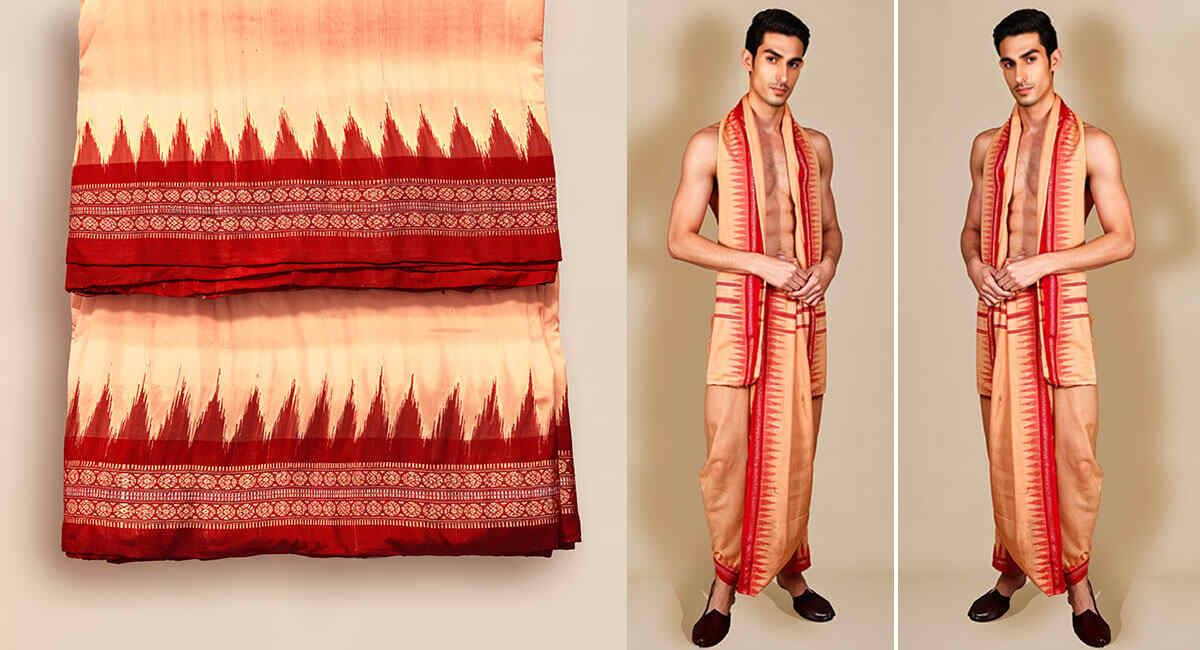Easy Guide for Wearing a Sambalpuri Dhoti
India is a land of vibrant cultures and rich textile traditions, each offering unique clothing styles rooted in regional identity. Among the diverse forms of Indian attire, the Sambalpuri dhoti stands out for its elegance, craftsmanship, and cultural heritage. Originating from the Sambalpur region of Odisha, this dhoti is more than just a garment—it is a testament to centuries-old weaving traditions, deeply woven into the fabric of Odia culture.
Handwoven with the renowned ikat technique, Sambalpuri dhotis feature complex motifs and vibrant colors. Whether attending a religious ceremony, a cultural function, or a festive celebration like Rath Yatra, learning to drape this beautiful attire can help you embrace tradition while making a bold statement. Everything you need to know will be covered in this comprehensive guide, including the basics of the garment, the draping technique, styling tips, and cultural insights.
What is a Sambalpuri Dhoti?
Skilled artisans make a Sambalpuri dhoti using the ikat dyeing method, tying and dyeing the threads before weaving them. This technique produces beautiful, symmetrical patterns such as shankha (conch shell), chakra (wheel), and phula (flower)—each bearing cultural and spiritual significance.
These dhotis are typically crafted from pure cotton or silk, making them lightweight and breathable, ideal for India’s tropical climate. Unlike mass-produced fabrics, every Sambalpuri dhoti reflects the handiwork of skilled weavers, who often take weeks to complete a single piece. This dhoti is commonly worn by men across Odisha, especially during religious rituals, cultural performances, weddings, and formal gatherings. It symbolizes respect for tradition and a strong connection to one’s roots.
Materials You’ll Need
Before you begin, gather the following:
- A Sambalpuri dhoti (typically 4 to 5 meters in length)
- A matching angavastram or Sambalpuri stole (optional, for added elegance)
- A mirror (to help align the drape)
- A belt or cotton string (optional but helpful for first-timers)
- Undergarments or fitted shorts (for added comfort)
Step-by-Step Guide on How to Wear a Sambalpuri Dhoti
Step 1: Preparation
Begin by choosing a spacious, flat surface, preferably in front of a full-length mirror. Wear a fitted inner garment or shorts for better grip and comfort. Iron the dhoti, if necessary, to eliminate wrinkles, which makes draping smoother and cleaner.
Step 2: Find the Center
Hold the dhoti horizontally and locate its midpoint. You can fold it in half vertically to help find the center accurately. Align this center point with your navel, allowing equal lengths of fabric to hang on both sides.
Step 3: Wrap Around Your Waist
Start wrapping the fabric around your waist from back to front. Bring both ends toward the front of your body and ensure that the ends are even. Tuck the left side of the fabric firmly into your waistband. This serves as the anchor point for the pleats you’ll form next.
Step 4: Pleat the Right Side
Take the dhoti’s right side and form 4 to 6 pleats, each about 2 inches wide. Hold the pleats firmly and bring them toward the center of your waist. Tuck them neatly into the front waistband so that they fall straight and evenly, giving the dhoti its graceful, layered look.
Step 5: Create the Kachha (Back Tuck)
Next, bring the remaining portion from the left side between your legs from front to back. This part is known as the kachha. Lift the fabric slightly for ease of movement, then tuck it into the waistband at the back. The kachha ensures comfort, especially when sitting or walking, and keeps the dhoti securely in place.
Step 6: Adjust and Style
Smooth out any folds or misalignments in the fabric. For extra support, especially if you’re new to wearing a dhoti, tie a thin belt or string around your waist. This will help keep the fabric secure throughout the day. Finish your look by draping a matching angavastram over one shoulder for a truly traditional appearance.
Tips for First-Time Wearers
- Practice makes perfect. Although draping the dhoti may feel awkward the first few times, it becomes second nature with practice.
- Use discreet safety pins at the waistband if you’re concerned about it slipping.
- Pair with a kurta or a Sambalpuri shirt to complete your ethnic ensemble.
- Traditional footwear, like leather Kolhapuri chappals or Peshawari sandals, complements the dhoti beautifully.
- Wear it during a quiet evening at home before donning it publicly to build confidence.
Styling Ideas to Elevate Your Look
To make your Sambalpuri dhoti ensemble stand out even more, do the following:
- Pair it with a plain silk kurta or a handwoven Sambalpuri shirt for a coordinated look.
- Add accessories like a rudraksha mala, a handwoven stole, or ethnic silver jewelry for a traditional vibe.
- Wear a headwrap or a pagri (turban) if the occasion demands it to complete the regal Odia aesthetic.
- You can also experiment with draping styles—some regional variations include wearing the pleats slightly to the side or tucking the back fabric more loosely for comfort.
Final Thoughts
Wearing a Sambalpuri dhoti is about more than style—it’s an homage to a centuries-old textile art and an expression of identity and respect for cultural roots. Each time you wrap this garment around you, you are carrying a legacy of skilled artisans who have kept the weaving traditions of Odisha alive through dedication and craftsmanship.
This comprehensive instruction can help even novices wear a Sambalpuri dhoti with confidence. You will experience the comfort and beauty of handwoven fabric and create a statement that honors heritage and genuineness. So, the next time you’re attending a cultural celebration, a wedding, or even exploring traditional wear, reach for that beautifully woven Sambalpuri dhoti—wear it with pride and walk gracefully.


